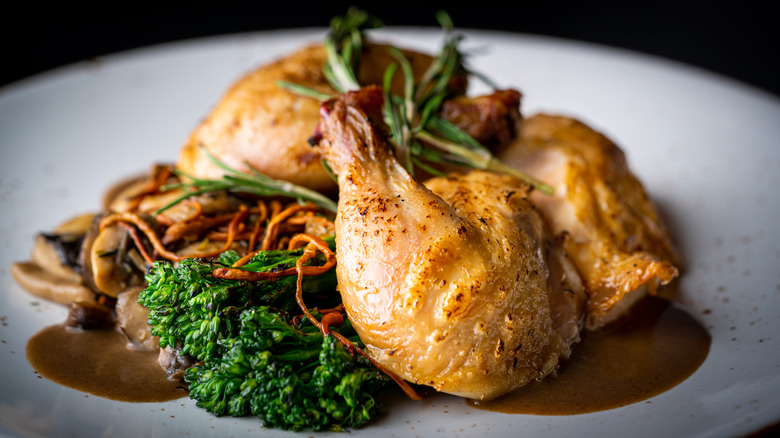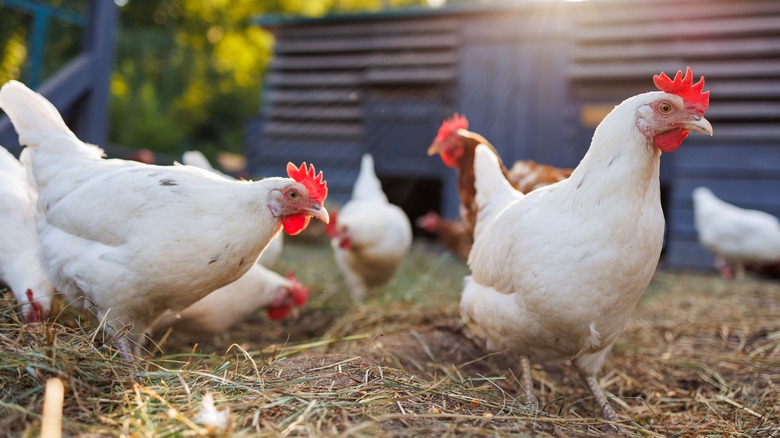No, You're Not Imagining It: Dark Meat Chicken Does Taste Better
In the age-old debate of dark meat versus white meat chicken, there's really no wrong answer (unless you're a vegetarian): They're both pretty wonderful, and each has its virtues. White meat, for instance, is milder, lighter, and a good source of protein. Taken from the breasts and wings of the bird, it has a clean, unchallenging taste that plays well in all sorts of preparations; you can just as easily stew it in a curry as you can poach it for chicken salad. And, of course, chicken breasts are the protein fueling the endless fried-chicken sandwich wars.
And yet, there's no denying the relative succulence of white meat's counterpart: dark chicken meat, which comes from the legs (aka thighs and drumsticks). Even if you prefer white meat's mildness, dark meat is simply richer and more flavorful. There's a simple reason why many people prefer darker meat: Like most things that taste good, it's higher in fat and calories. That fat also makes the meat juicier, which means it's harder to overcook. Whether you're cooking at home or eating out, you're likelier to get a tough, dried-out chicken breast than a tough, dried-out chicken thigh. That's just science.
The difference between the dark meat and white meat in chickens — and turkeys, for that matter — boils down to muscle composition and how it affects the nutrient profile of each type of meat. Here's a little more on what gives dark meat its color and, therefore, its delicious flavor.
What makes some chicken meat darker?
Chickens have two types of muscle fibers: white and red. These are found in varying levels in all chicken muscles, with the muscles in the legs containing about 50% red fibers and the muscles in the breasts and wings containing only about 10% red fibers. Why? It's because, while white fibers (aka fast glycolytic muscle fibers) are mostly used for brief movements, the birds use red fibers (aka slow oxidative muscle fibers) for more sustained activity, like standing around. Birds bred as poultry, of course, do this a lot since they're flightless. Muscle-wise, if you're a chicken or a turkey, the legs and the thighs are where most of the action is.
These cuts are particularly high in a protein called myoglobin, which helps support all this activity by transporting oxygen to the muscles from the bloodstream. Myoglobin is rich in iron and has a purple color that turns red when exposed to oxygen — hence the darker color of dark meat. This is true of meat in general, by the way; myoglobin is also what gives beef its reddish hue (mixed with water, myoglobin can also account for the pinkish liquid you see in packages of raw meat — it's not blood!). Myoglobin levels also increase with age, so meat from older animals tends to be a little darker.
What's the nutritional difference between white and dark meat chicken?
Red muscle fibers contain more fat and proteins than their white counterparts, so it's true that chicken legs and thighs are fattier and more caloric — more nutrient-dense, in general. Often, this has caused calorie-conscious people to opt for white meat. Pound for pound, there's some slight difference here: In addition to having less fat and fewer calories, light chicken meat also has a bit more protein than its darker counterparts. But, in truth, the differences aren't all that profound, and for its part, dark meat is richer in nutrients like iron, zinc, and vitamin C. Nutritionists have ended up going pretty easy on the whole question: A mix of dark and white meat chicken will help ensure you're getting the whole array of nutrients that your body needs. One more argument in favor of the whole roast chicken (which you can also use to baste your vegetables).
An exception? While the majority of fat in both white meat and dark meat chicken is unsaturated (i.e., the better kind), dark meat is slightly higher in saturated fats (i.e., the worse kind). So, folks who are on heart-healthy diets may have cause to stick to the lighter side of the bird. The rest of us can keep fighting over which cuts we like best.


